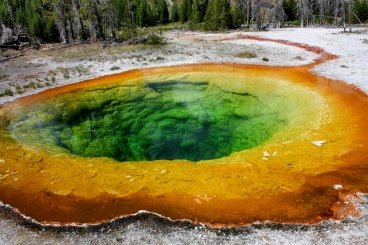Current manufacturers of solar cells have been able to produce solar devices with sunlight to electricity conversion efficiency not exceeding 20%. In this industry, even a 1% improvement would be hailed as significant progress.

Green sulfur bacteria in a hot spring at Yosemite National Park
Nature however surpasses man on the strength of billions of years of evolution to perfect the photosynthesis process. Green sulfur bacteria which thrive in the depths of the oceans where light can hardly penetrate are capable of harvesting 98% of the scant light energy that reaches them.
Researchers at MIT have built an artificial system of dye-based nanotubes that is modeled on the light harvesting bacteria. The system comprises cyanine dye molecules that self-assemble into identical double-walled nanotubes that are 10 nm in width and several thousand times longer. The tubes are similar to the receptors of the green sulfur bacteria in shape, size and function. This system is not suitable for real-life applications and is intended only for gaining insight into such light harvesting systems that could facilitate the development of appropriate materials for light harvesting. The uniformity in structure allows the system to be studies in bulk instead of spending time and effort in isolating performance of each tube. In order to assess the contribution of each wall of the double-walled nanotube in harvesting the incident light, the optical response of the outer wall of one tube was killed by oxidizing the outer molecules. The resulting reaction showed that the two walls are capable of functioning as two separate systems. The team’s aim is to build completely new light-harvesting systems rather than improve the efficiency of current ones.
Source: http://web.mit.edu/
Disclaimer: The views expressed here are those of the author expressed in their private capacity and do not necessarily represent the views of AZoM.com Limited T/A AZoNetwork the owner and operator of this website. This disclaimer forms part of the Terms and conditions of use of this website.